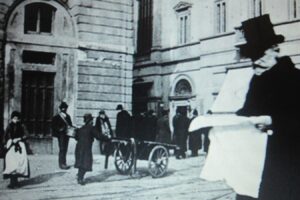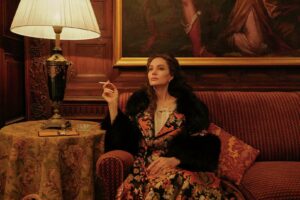

Last year in the same space Jennifer Peterson’s group gave the US stage premiere of Handel’s first opera Almira.
Perhaps they are planning to work chronologically through the composer’s oeuvre since this year we got his fifth opera as the three German-Italian works he composed for Hamburg to follow-up on the success of Almira have not survived. Handel’s trip to Italy proved the crucial moment in his development as a composer, particularly as a composer of vocal music, arriving in Florence in 1706 at the age of 21.
By the next year he had moved on to Rome where he composed his first fully Italian opera Vincer se stesso è la maggior vittoria (To conquer oneself is the greatest victory), more easily known by its hero’s name—Rodrigo–for a premiere at Florence’s Teatro Cocomero in late 1707. After those performances, the work disappeared completely until its resurrection at the 1984 Innsbruck Festival, conducted by Alan Curtis, whose excellent 1997 complete recording far outshines a more recent effort
by Eduardo López Banzo.
Although Winton Dean in the first volume of his towering study of Handel’s operas gives Rodrigo a hard time, we do find the composer still finding his way, but the score, while not the masterpiece his next opera Agrippina would be, contains many memorable arias (some familiar from the many cantatas he wrote during this time) that could only be by Handel, plus the very first of his great duets for the hero and heroine “Prendi l’alma e prendi il core.”
Part of Rodrigo’s problem is that that hero is quite an unlikeable chap—a King of Castille who has seduced and impregnated Florinda, the sister of his trusted general Giuliano who has been assisting his ambitions to conquer Aragon, whose king Evanco has been captured.
Despite his ruthless political and erotic maneuvering, Rodrigo’s barren queen Esilea remains fanatically loyal to him, magnanimously offering to step aside and let Florinda and her child ascend to the throne. Of course, Rodrigo eventually sees the errors of his ways and returns to his faithful wife while a chastened Florinda (who spends most of the opera plotting vengeance on the duplicitous Rodrigo) turns her amorous attentions to the newly freed Evanco.
Dean’s critique of the opera often has to do with problems with the libretto, one derived from Francesco Silvani’s for M.A. Ziani’s 1699 opera Il duello d’amore e di vendetta. However, many adjustments were made for Handel–due to the excellence of the tenor assigned to the role of Giuliano, his character’s music grew from two arias in the Ziani original to seven in Handel’s final version.
Evanco has three arias in the first two acts of Rodrigo, then three more (all pretty much on the same subject—his hopeful love for Florinda) unhelpfully bunched together within the final six numbers before the final coro.
Yet nearly all the arias are beguiling, moving and most of all revelatory of their characters,
while still occasionally providing the opportunity for the singer to display his florid skills.
Tuesday’s mostly-American cast—directed simply but effectively by Jeff Caldwell—was not the last word in virtuosity, yet it by and large gave committed, persuasive performances.
The performance did not begin promisingly, however. As Peterson’s edition chose not to reconstruct music missing from the material rediscovered in the 70s and 80s, the performance began (after the nearly 20-minute overture) with Florinda’s first aria “Pugneran con noi le stelle” in which Madeline Bender got spectacularly lost during the da capo repeat. After her exit and extensive re-tuning by the orchestra, Esilea and Fernando entered both carrying binders.
At first, I wondered if Bender’s crash had caused the other performers to re-think their need for scores; however, Rodrigo and Giuliano soon arrived without theirs, although Evanco had his. It was all very confusing until I heard at intermission that a miscommunication had led half of the cast to believe that they would be performing with scores (perhaps as City Center’s Encores series does with revivals of Broadway musicals).
Heading a cast of two sopranos, three countertenors and one tenor (there are no low voices), Nicholas Tamagna in the title role shone brightest with his pure, steady countertenor and his committed, anguished portrayal of the bad-guy hero.
Reminding me more than once of Max Emanuel Cencic, a bald-pated Tamagna displayed an easy high extension; however, the voice was at its most attractive in its middle register. He was particularly effective in Rodrigo’s vibrant “Vanne in campo” and his touching “Dolce Amor.” This was my first exposure to Tamagna, and I look forward to hearing him again.
Daniel Bubeck in the secondary role of Fernando revealed a substantial mellow and agile alto that ably put over his showpiece “Dope i nebi” making his murder in the second act doubly unfortunate. The third countertenor Christopher Newcomer struggled in the high-lying role of Evanco which was written for a female soprano. While I think there may be a promising voice there, Newcomer was distractingly glued to his score, and his less-than-ideal acquaintance with his music resulted in more than a few awkward moments.
While a particularly jejune actor, tenor John Carlo Pierce made a mostly successful stab at Giuliano’s demanding arias, displaying more than adequate agility and a fine way with the text.
A fiery Bender, once past that unfortunate first aria, also passionately declaimed the recitatives and agilely negotiated her arias, tempering her virago-like stalking of Rodrigo to melt convincingly toward Evanco. It was good to see Bender again as I had completely lost track of her after her big splash as Eurydice in the Robert Wilson–John Eliot Gardiner production of Gluck’s Orphée et Eurydice in the late 90s.
The singer with the shiniest pedigree was in some ways the most disappointing: Icelandic soprano Dísella Lárusdóttir, the MET’s most recent Woglinde, often failed to bring Esilea’s passionate fortitude and noble suffering to life. She was dependent on her score at every moment, which proved very distracting.
Though mostly bright and secure on top, her chilly soprano lacked crucial fullness in the middle. And more than anyone else, she displayed a real lack of ease in the recitatives—all too often phrases just petered out. Perhaps inspired by Tamagna, she ended strongly in Rodrigo and Esilea’s bewitching reconciliation duet.
More than in Almira, operamission’s great good will in performing these important rare operas was undermined by the serious lack of rehearsal, particularly of its 15-member period orchestra which played with enthusiasm but all too often just wasn’t together—the transition from the B section to the repeat of the A section in an aria threatened to come apart time and again.
That several important chairs are changing from night to night during the run—the first cello, double-bass and first oboe—is particularly disturbing in light of these ensemble problems. One shining light, however, was the fine playing of the frequently virtuoso solo violin music by Joan Plana.
After that rambunctious first act, I was frustrated and disappointed by the lack of cohesion and the “by the seat of their pants” spirit sometimes on view. But by the middle of the second act I had relaxed and warmed to the infectious spirit and enthusiasm of the musicians involved, not that the number of “accidents” declined. It did make me wonder how together the singers and orchestra usually were in Handel’s time when the music was usually completed only weeks before the first performance.
I left the Gershwin grateful for the chance to hear this fascinating step in Handel’s operatic journey yet frustrated that such good intentions and hard work are compromised by the lack of adequate funding. I wish some generous individual or well-meaning foundation would cough up the necessary support to permit this organization (as well other small local groups) to do the fine work that moments of this Rodrigo revealed Peterson and her colleagues are capable of.
Those unable to attend the remaining two performances of Rodrigo may watch a webstream of Saturday’s final performance.
Illustration: Tomi Um.

























Comments